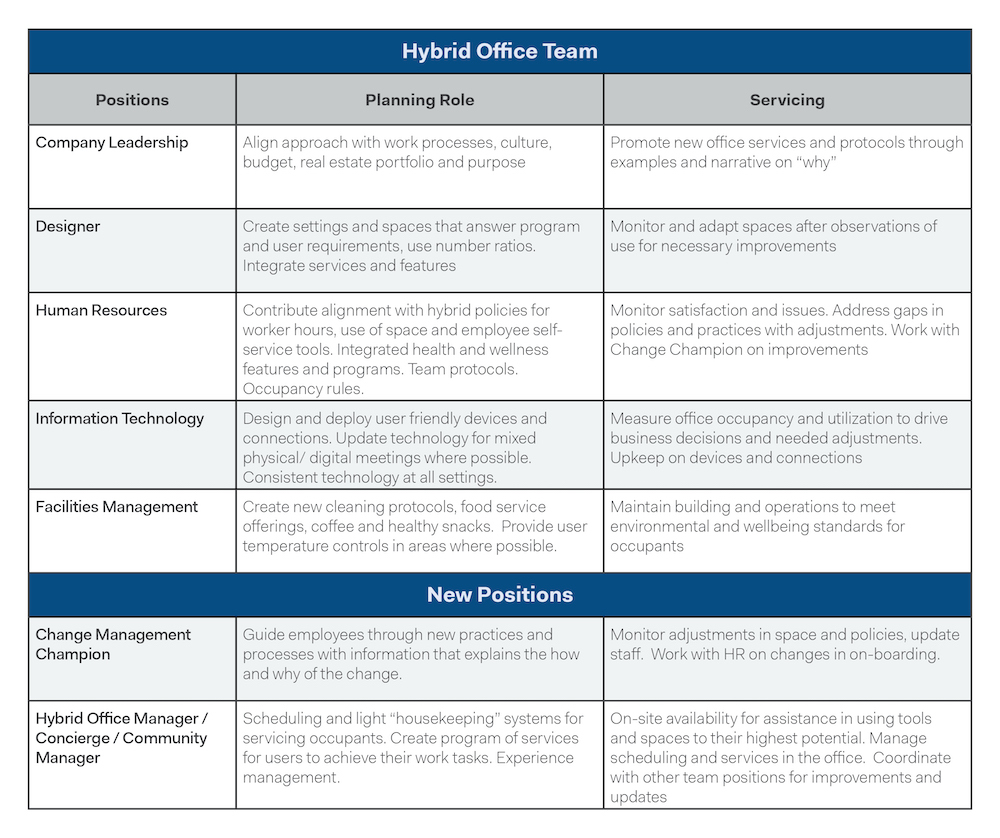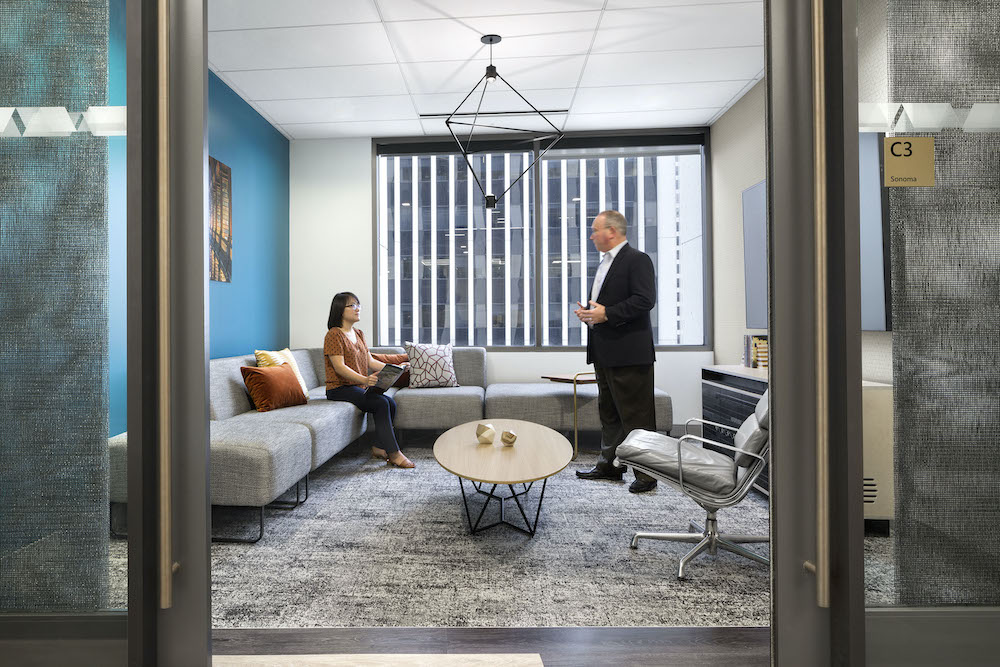FCA’s Ann Hoffman and Rachel Howren explore how workplace roles are changing in response to hybrid work.
“Hybrid” is the disruption we never planned for. It remains the most undefined term in business vernacular. While it can refer to schedule, employee archetype, or office landscape, it brings to the forefront the need to reimagine old paradigms and create services and features that most offices never had. We’ve come to understand that the office experience needs to be “commute worthy.” Just as we would expect the experience at a good restaurant to surpass the one at home, the office needs to support employees at that same level when compared to the home office. If the new work model provides fully unassigned seating with alternative work settings, it will need to have service functions that cross over into hospitality.
Reception areas are becoming less occupied as meetings are held online and visitors are hosted virtually. Receptionists are not performing the same pre-pandemic roles and their efforts are more likely directed elsewhere. The redesign of the receptionist role could lead to the creation of a Hybrid Office Manager (sometimes referred to as the Concierge or Community Manager depending on office size and company culture).
A concierge can close the gap between worker and place to create a high-performing office environment as ownership is given away to membership.
This new role can contribute to the success of the hybrid experience: replacing ownership of a singular space with the choice of many spaces. A concierge can close the gap between worker and place to create a high-performing office environment as ownership is given away to membership. Their contribution adds to the experience in unmeasurable ways. As a user leaves their space at the end of the day, is it ready for someone new to occupy and receive the same experience? Are the supplies or devices they need in place? Is technical help available as needed? Can they schedule space for an extended time? Those small, attentive and upgraded services set the office experience apart from the home and make it more valuable.
Planning for Hybrid Function
The reimagined hybrid is more than office desks and meeting spaces. In the resizing and renovation of hybrid offices, the best approach brings in the multidisciplinary team of leadership, human resources, information technology, and facilities management. The application of unassigned and reservable seating to leverage empty real estate requires the functions of hospitality to intersect with those of human resources, facilities management, and IT. Hybrid landscapes done well have curated spaces and experiences to answer every task and the diversities of its potential user. All these functions require interface and maintenance to remain viable as a location of choice. As designers, it’s our job to bring these groups to the table and ask the right questions. While instituting these new features, the traditional roles for managing the office have changed too––bringing these services to employees takes a coordinated team.

The pandemic has also forced leadership to look at the built space differently. We have seen a significant increase in the number of companies who are engaging employees at all levels for feedback and input on the workplace; endorsing a more robust conversation about how an office functions. The empty space in offices pushed leadership to acknowledge that something needed to change and is leading to a reduction in footprint to accommodate quality and highly purpose-driven design. Organizations are now considering how the physical office can serve as a place to connect with teammates, represent company culture, support socialization and collaboration, and provide natural opportunities for mentorship. Pressed with maintaining cohesiveness and culture, leadership can aid in these efforts through modeled behavior and promotion of why maintaining a connection to the office, even for a few days a week, is important.
As we straddle the worlds of virtual and physical, technology has the biggest burden to bear in reinventing the delivery system. Most offices we left behind in March three years ago were not prepared for this radical shift in how work happens. The interface of our technology, our devices and tools are critical to the success of any space the new hybrid worker occupies and our IT leaders are at the forefront of this design. Our technology programs must address continuity among spaces, camera angles and backgrounds, lighting, and acoustics to maintain a high quality experience. Plug-and-play technology and allowing users to transition from a focused-work setting to a team meeting or collaborative area with ease is a win for end users.

IT teams can also provide invaluable information and resources when it comes to analyzing occupancy and utilization. Many systems and programs are available to allow companies to see when their teams are in the office to be able to effectively schedule meetings and get the most out of their time there. IT solutions can also be instituted to allow teams to track occupancy, giving companies more insight into office utilization. Data on office use supports larger decisions such as square footage requirements or additional resources needed to strengthen the user experience.
Human Resource managers have been at the center of a lot of disruption. Attracting the best talent and keeping employees engaged is a constant cycle of effort. Adding to their tasks: the creation and broadcasting of new hybrid policies and benefits. Younger generations are more concerned about whether a company’s culture and values align with their own. What benefits are being offered? What are the company’s ESG goals or policies? Does this company take my health and wellbeing into consideration? At the design table for the new hybrid office, HR’s voice has never been more critical. Accommodating a diverse workforce and instituting health and wellness sensitivities into the office design are features HR can promote to all employees.
Facilities Managers are still performing all their previous tasks with a new twist: unpredictable occupancy levels––this makes their challenging job even harder. The exercise in collecting data as we settle into hybrid work will ease the uncertainty to a point. But now all their services need to be available and scalable to accommodate the fluctuation in utilization.

Creating New Positions
With fluctuating operations, policy and services, the hybrid team will need the support of a change management champion. With an eye on constant improvement, the hybrid workplace will evolve and change. To keep these changes relevant and users informed, a change management champion’s function will be to broadcast the explanation of the “what” and “why” to the workforce while expressing the benefits for all.
New hybrid settings are best experienced when the user understands their operation and can intuitively engage with their surroundings. The Hybrid Manager can make sure that the experience is aligned with the intent, and that the user is unencumbered by their environment. No small task, but a great position for those who embrace it and enjoy solving problems and helping people.


